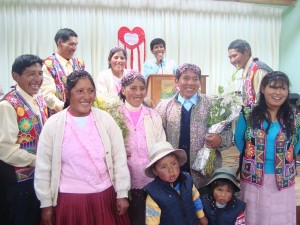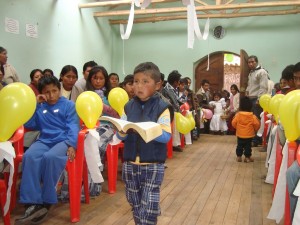Marrying in Cuzco

Sharing love is often not only between two people. It can involve many more, often an entire community. If it is true that getting together as a couple today is not always done for love, but for other interests, let us look further.
Today, here in Cuzco, people marry in the Catholic Church, as has been the custom since the arrival of the Spanish How did people marry before then? Today when we think of marriage the image comes to mind of the bride, dressed in white, and the groom in a suit along with a host of friends and family, But, in Tawantinsuyo, as the Inca Empire called itself, things were different.
When a couple would meet, and like each other, they would first decide to enter into what is called “sirvinakuy”, to serve or help each other. They would live together for a period of time, a year or more, to see if they got along well so that later they could contract marriage or break up. In Tawantinsuyo, therefore, couples could get together and have children without yet marrying formally.
What would happen then, if at the end of the period of sivinakuy there were children. As has been seen when anthropologists and others look at traditional communities, such as Q’eros, the child of such a relationship would not stay with either the father or the mother, but would be raised by the oldest grandparents of the couple. It would be raised with all the wisdom of the grandparents and, in the future, would be the inheritor who would follow the steps of that grandparent. In some cases, the child would become the altomisayoq, a respected person with a lot of wisdom who speaks with the pachamama, mother earth, and with the spirits of the mountains, the apus.
But if the couple decided to continue with their relationship, now older and often with children, then they would follow a sequence of steps, including the man asking his wife’s family for permission to marry their daughter.

Tawantinsuyo was a confederation of many different peoples, each with their own customs. As a result, there was probably a lot of variation in how different peoples carried out the process of marriage. But, since there aren’t a lot of written sources to tell us about the preparations and rituals of marriage, we can look at the traditions and customs in rural communities near the city of Cuzco to give us an idea of this special event.
To the north of Cuzco there is a place called Pacas. It is on the border between Cuzco and Apurimac, as Luis Kcana tells us. He is from there and now lives in the city of Cuzco. He relates that in order to ask for the woman’s hand, after living together, the man and his entire family visit the the woman and her kin, accompanied by the sound of flutes, pinkuyllos. The man’s mother brings flowers, such as kantus–an ancient sacred flower in Cuzco, to put on the bride’s head.
In order to carry out a marriage ceremony, they must first ask permission of the earth, the Pachamama.
Like in Pacas, many other communities do something similar. Sometimes the woman will weave something special for her future husband as a symbol of agreement to marry. In others the man visits the woman’s family taking with him for them all the best agricultural products that were harvested so that the family can host the celebration with a meal for the guests. And there are other customs as well.
But the most fascinating thing is how the events are carried out. Even though some couples today marry in the Church, the preparation for the feast is different in a community to the southwest of Cuzco called Yarcacuna in the province of Acomayo.
Luis Kcana who participated in this ceremony tells us about it.
Early in the morning, the family of the groom, look through their alpacas o llamas to find the biggest and fattest. It is then sacrificed. Its heart will be burned as an offering of thanks and its flesh will be divided.
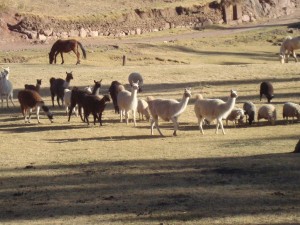
The meat is cooked to be served the the families and guests as the typical food for the celebration. Maybe this is like in Inca times where for important feasts a Llama was sacrificed. It seem people benefit from this procedure as part of weddings.
The first day of the feast is held in the home of the newlyweds. They serve all present chicha, a corn beer, as well as food. On the second day the couple will visit the home of the bride’s parents, where they along with the guests are served food. Then they go to the house of the groom where they are also received and feted.
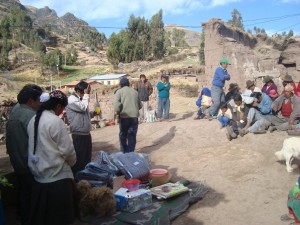
But the most interesting thing is the obligation of the guests to spend the two days with the couple. They are not invited with a invitation card, as we do here in the city, but it is as if they were a single family. It is their obligation to the new couple to be present at the feasting.
As we noted, the first dish served to celebrate this great event is an asado de llama, or roast Llama, with potatoes. It is shared with great affection to all present and is served in great abundance so that every person in this way can share in the celebration of the marriage.
Another special custom shared in many places, and not just in the city of Cuzco, is the T’ipanakuy (which is the giving of gifts to the couple by the guests). Maybe in ancient times people only gave agricultural produce or maybe even animals or houses, as our grandparents mention. But today, now that money has been introduced, in the T’ipanakuy, it is usual to see people pin money to the clothes of the bride and groom. It devolves into a kind of competition to see who will pin more money, the bride’s side or the groom’s.
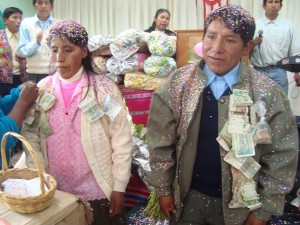
Since in almost all case when people emigrate from the countryside to the city they start forgetting the traditions they lived from generation to generation, little by little this custom is disappearing.
But people in the countryside, and in the city, enjoy weddings since they bring a lot of fun and joy. They share the couple’s love with the whole community and the community celebrates it with happiness and joy.
